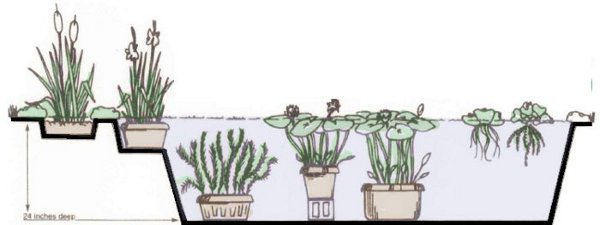

| POND SETUP GUIDES Home About Us Ordering Info Plants Pond Setup Guides Contact Us   |
Water
Plants DO Serve a Valuable Function in Your Pond!!! Every pond keeper has a choice of how to keep their water clear and in balance: 1. Mechanical – this method uses a pump to force pond water through a mechanical filtration device. This system requires regular maintenance throughout the year and after encourages the use of chemicals. 2. Natural – this method relies on the correct selection of aquatic plants to establish an ecological balance in the pond. Once plants mature to desired levels, maintenance is minimal. Floating plants will help increase oxygen levels benefitting fish and plants 3. A combination of above methods is most realistic, with emphasis on finding the desired ecological balance for your pond. The following information explains the function of each category of aquatic plants in your pond… 
Bog Plants – This category of plants has a huge selection of varieties. The sheer number of choices makes it fun to experiment with and find ways to use all the different plants. They add vertical accents and a variety of textures, which gives visual interest to your garden, while at the same time, softening the edges of your pond where land and water meet. They also assist in the function of removing excess nutrients from the pond and providing some shade. Oxygenating Plants – This category of plants is CRITICAL to the success of a balanced pond. Often overlooked due to their lack of a showy flower, these plants are essential for several reasons. The 2 most common are Hornwort (Ceratophyllum demersum) and Anacharis (Egaria densa). **These plants compete with algae for dissolved nutrients, thus reducing algae growth. **They provide valuable shade within the pond, helping maintain stable water temperatures. **They provide a natural spawning area for fish. **They can be a valuable food source and give good protection from predators, especially in the winter. Sold bu the bunch, begin stocking your pond with a maximum of one bunch for every 2 square feet of surface area. Plant in pots of pea gravel, or in rocks on your pond bottom. No soil is required as they thrive on dissolved nutrients in the water. Floating Plants and Water Lilies – These 2 groups of plants together serve a vital function in the pond – Surface Coverage! The general rule is a maximum of 70% surface covered, less in larger pools. The fuction provided by either floating plants, or water lily pads, is to create shade in the water. This shade keeps too much sunlight from getting in the water, which restricts algae growth and stabilizes water temperature. This cooler water is less stressful on fish and reduces the evaporation process. The floating plants, primarily water hyacinth and water lettuce, reproduce very quickly and will likely need to be thinned out (they make great mulch!). The massive root systems on the adult plants are great water purifiers, absorbing excess nutrients and balancing the pH, slowing down algae growth. The roots are ideal spawning sites for fish. **Added Note: Fish in ponds…In a functional sense, fish do their part to balance your pond. Fish and algae are interdependent. Fish help keep water clear by eating algae (as long as you do not OVERFEED them!!) Feed fish about every 3 days during active season when pond water temperature is near, or above 70 degrees. Fish waste, however, fertilizes algae, stimulating their growth. When the pool is balanced, fish flourish and algae is less likely to get out of control. Fish also limit the mosquito population be feeding on larvae! POND STOCKING GUIDE This guide is intended for use by landscape designers or individuals as an idea for recommended quantities of plant material for ponds. As always, the owners’ personal preferences or site considerations may cause some deviations from this guide. This guide is based on the pond’s surface area in square feet. You can determine the surface area by using the following formulas:
PLANTING SUGGESTIONS
|